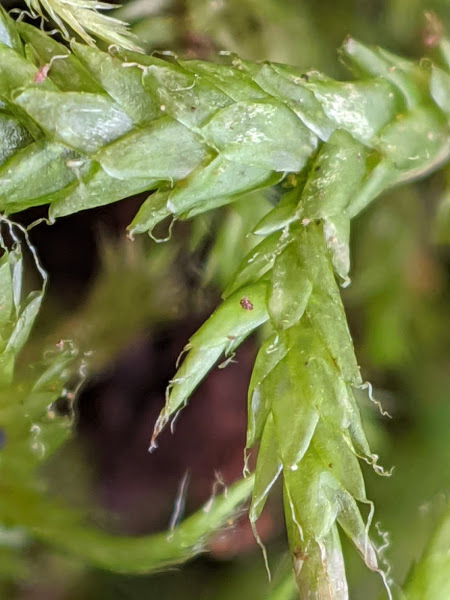Wijkia
Dioicous. Asexual reproduction by flagelliform brood branches with microphyllous leaves at branch apices. Mats on logs, tree bases or less commonly soil or rocks. Stem creeping, irregularly subpinnately to irregularly bipinnately branched, often with cuspidate branches, with fascicles of rhizoids; pseudoparaphyllia present, foliose and deltoid; central strand absent. Stem and branch leaves clearly differentiated, erect to wide-spreading when moist, scarcely altered when dry, arranged around stem and facing all directions; costa absent; laminal cells elongate-rhomboid to linear, smooth to seriately papillose; alar cells well-differentiated, strongly inflated and pigmented or hyaline in basal row, otherwise quadrate to oblong for several rows. Stem leaves broadly ovate to oblong; apex rounded or obtuse, often with a hairpoint; margin serrulate at apex, plane, without a border. Branch leaves smaller than stem leaves, ovate-lanceolate or lanceolate; apex acute, often with a hairpoint; margins usually more distinctly serrulate toward apex than in stem leaves, plane, without a border. Capsules horizontal, asymmetric, obloid to cylindric, without an annulus. Calyptra cucullate, smooth, glabrous. Operculum conic. Peristome double; endostome with segments similar height as exostome, with a high basal membrane; cilia present.
Forty-nine species have been included in Wijkia (Crum 1971), but the true number is much less due to some of these species being better considered synonymous (e.g. Ramsay et al. 2002) and most are likely misplaced in Wijkia (see note below). Wijkia is distributed between India and the Pacific Islands, with one species occurring in Victoria.
Wijkia in its current circumscription includes unrelated species and is in need of worldwide revision (Carvalho-Silva et al. 2017; Han & Jia 2021). Some species of Wijkia sampled in phylogenetic studies based on DNA sequences from all genomic compartments, including the type species W. extenuata (Brid.) H.A.Crum, are placed close to Isocladiella and Acanthorrhynchium. Others are well separated from the previous species, instead either being placed close to Brotherella and Pylaisiadelpha, or in the case of W. trichocolea (C.Müll.) H.A.Crum, in an isolated position (Carvalho-Silva et al. 2017; Han & Jia 2021). This division in the phylogeny corresponds to sectional division established by Brotherus (1925), with the first set of species placed in section Wijkia, the second in section Tanythrix and W. trichocolea is in section Acanthocladiopsis (Buck 1986; Han & Jia 2021). Section Wijkia is characterised by plants that are subpinnately branched with well-differentiated stem and branch leaves, multitiered inflated alar cells, a short operculum, laminal cells that are sometimes papillose and branches that are usually flagelliform (Han & Jia 2021). The description provided here applies only to section Wijkia.
 Spinning
SpinningBrotherus, V.F. (1925). Musci (Laubmoos), in Engler, A. (ed.), Die natürlichen Pflanzenfamilien, edition 2. Bd 11. Engelmann, Leipzig.
Buck, W.R. (1986). Wijkia (Sematophyllavceae) in the New World. Hikobia 9: 297–303.
Carvalho-Silva, M.; Stech, M.; Soares-Silva, L.H.; Buck, W.R.; Wickett, N.J.; Liu, Y.; Câmara, P.E.A.S. (2017). A molecular phylogeny of the Sematophyllaceae s.l. (Hypnales) based on plastid, mitochondrial and nuclear markers, and its taxonomic implications. Taxon 66: 811–831.
Crum, H. (1971). Nomenclatural changes in the Musci. The Bryologist 74: 165–174.
Han, W.; Jia, Y. (2020). Phylogeny and classification of the Sematophyllaceae s.l. (Hypnales, Bryophyta). *Journal of Systematics and Evolution * 59: 524–540.
Ramsay, H.P.; Schofield, W.B.; Tan, B.C. (2002). The family Sematophyllaceae (Bryopsida) in Australia. Part 1: Introduction, family data, key to genera and the genera Wijkia, Acanthorrhynchium, Trimegistia and Sematophyllum. *Journal of the Hattori Botanical Laboratory * 92: 1–50.


